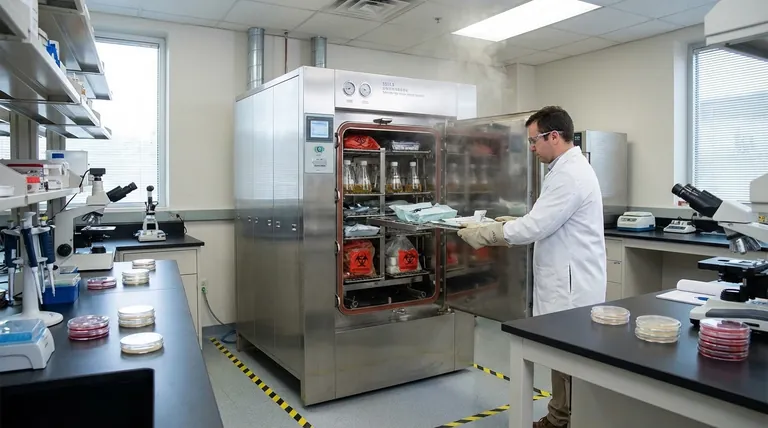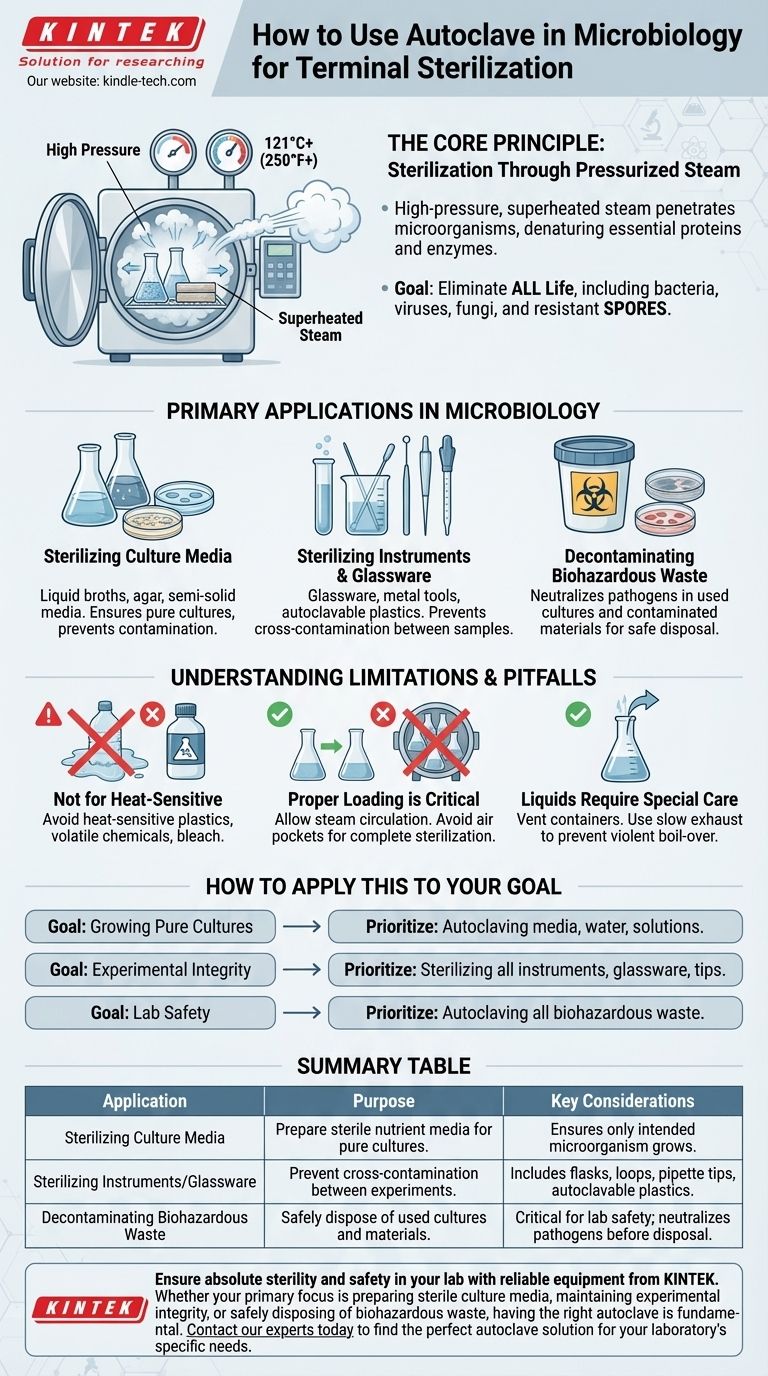In microbiology, an autoclave is the definitive tool for terminal sterilization. It is used to render laboratory equipment, culture media, and biohazardous waste completely free of all life forms, including bacteria, viruses, and highly resistant spores. This is achieved not just with heat, but with high-pressure, superheated steam, which penetrates and destroys microorganisms far more effectively than simple boiling.
The core function of the autoclave is not merely cleaning, but achieving absolute sterility. This is the non-negotiable foundation for preventing contamination, ensuring the validity of experimental results, and maintaining a safe laboratory environment.

The Core Principle: Sterilization Through Pressurized Steam
An autoclave operates on a principle similar to a sophisticated pressure cooker. By increasing the pressure within its chamber, it allows water to boil at temperatures well above the standard 100°C (212°F), typically reaching 121°C (250°F) or higher.
How Pressurized Steam Works
The combination of intense heat and high pressure creates saturated steam. This steam forcibly penetrates materials and transfers heat efficiently, denaturing the essential proteins and enzymes that all microorganisms need to survive.
This method is far more effective than dry heat because the moisture in the steam accelerates the destruction of microbial structures.
The Goal: Eliminating All Microorganisms
The primary objective is to kill every living thing, including the toughest forms of microbial life. This includes vegetative bacteria, viruses, fungi, and most importantly, bacterial endospores, which are known for their extreme resistance to heat and chemicals.
Primary Applications in the Microbiology Lab
The autoclave is involved in the full lifecycle of a microbiology experiment, from preparation to disposal. Its use cases can be divided into two main categories: preparing for research and cleaning up afterward.
Preparing Sterile Culture Media
To grow a specific microorganism, you must start with a nutrient-rich medium that is completely sterile. The autoclave sterilizes liquid broths, semi-solid media, and solid agar before they are used, ensuring that only the organism you are studying will grow.
Sterilizing Instruments and Glassware
Every tool that will come into contact with a culture must be sterile to prevent cross-contamination. This includes glassware like flasks and test tubes, metal instruments like inoculation loops, pipette tips, and certain types of autoclavable plastics.
Decontaminating Biohazardous Waste
After an experiment is complete, all cultures, used petri dishes, and contaminated materials are considered biohazardous waste. Autoclaving this waste is a critical safety step that sterilizes it before it can be safely discarded, preventing the release of potentially harmful organisms.
Understanding the Limitations and Pitfalls
While incredibly effective, the autoclave is not a universal solution. Understanding its limitations is crucial for safety and proper use.
Not for Heat-Sensitive Materials
The intense heat and pressure will destroy or melt many materials. Heat-sensitive plastics, certain medical devices, and volatile or corrosive chemicals (like bleach) should never be placed in an autoclave.
Proper Loading is Critical
Items must be loaded in a way that allows steam to circulate freely. Overpacking the chamber or sealing containers tightly can create air pockets or cool spots where steam cannot penetrate, leading to incomplete sterilization.
Liquids Require Special Care
When autoclaving liquids, containers must be left partially open or vented to prevent the container from shattering under pressure. Furthermore, the cycle must include a slow cooling and venting phase to prevent the superheated liquids from boiling over violently when the door is opened.
How to Apply This to Your Goal
Your specific use of the autoclave depends directly on the task at hand.
- If your primary focus is growing pure cultures: Your top priority is autoclaving your media, water, and solutions to eliminate any pre-existing microbes that would invalidate your results.
- If your primary focus is experimental integrity: You must sterilize all instruments, glassware, and pipette tips to prevent cross-contamination between different samples.
- If your primary focus is lab safety: Your most critical task is autoclaving all biohazardous waste to neutralize any potential pathogens before disposal.
Ultimately, mastering the use of the autoclave is fundamental to conducting credible and safe work in any microbiology laboratory.
Summary Table:
| Application | Purpose | Key Considerations |
|---|---|---|
| Sterilizing Culture Media | Prepare sterile nutrient media for pure cultures. | Ensures only the intended microorganism grows. |
| Sterilizing Instruments/Glassware | Prevent cross-contamination between experiments. | Includes flasks, loops, pipette tips, and autoclavable plastics. |
| Decontaminating Biohazardous Waste | Safely dispose of used cultures and materials. | Critical for lab safety; neutralizes pathogens before disposal. |
Ensure absolute sterility and safety in your lab with reliable equipment from KINTEK.
Whether your primary focus is preparing sterile culture media, maintaining experimental integrity, or safely disposing of biohazardous waste, having the right autoclave is fundamental. KINTEK specializes in providing high-quality lab equipment and consumables to meet the rigorous demands of microbiology.
Contact our experts today to find the perfect autoclave solution for your laboratory's specific needs and achieve non-negotiable sterility for credible results.
Visual Guide

Related Products
- Laboratory Sterilizer Lab Autoclave Herbal Powder Sterilization Machine for Plant
- Laboratory High Pressure Steam Sterilizer Vertical Autoclave for Lab Department
- Desktop Fast Laboratory Autoclave Sterilizer 35L 50L 90L for Lab Use
- Desktop Fast Laboratory Autoclave Sterilizer 20L 24L for Lab Use
- Portable Digital Display Automatic Laboratory Sterilizer Lab Autoclave for Sterilization Pressure
People Also Ask
- What is the function of autoclave in tissue culture laboratory? Ensure Absolute Sterility for Successful Cell Growth
- What is an example of autoclave in laboratory? Essential Sterilization for Reliable Science
- What is an autoclave used for in a lab? Achieve Total Sterilization for Lab Safety and Integrity
- What is the most common machine used to sterilize medical supplies? The Definitive Guide to Autoclaves
- Is an autoclave the same as a steam sterilizer? Understanding the Key to Reliable Sterilization



















